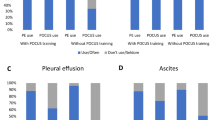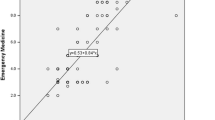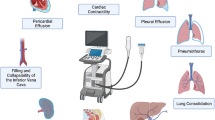Abstract
Purpose
To compare point-of-care ultrasound and physical examination (PEx), each performed by first-year medical students after brief teaching, for assessing ascites and hepatomegaly. Ultrasound and PEx were compared on: (1) reliability, validity and performance, (2) diagnostic confidence, ease of use, utility, and applicability.
Methods
A single-center, randomized controlled trial was performed at a tertiary centre. First-year medical students were randomized to use ultrasound or PEx to assess for ascites and hepatomegaly. Cohen’s kappa and interclass coefficient (ICC) were used to measure interrater reliability between trainee assessments and the reference standard (a same day ultrasound by a radiologist). Sensitivity, specificity, accuracy, positive predictive value (PPV), and negative predictive value (NPV) were compared. A ten-point Likert scale was used to assess trainee diagnostic confidence and perceptions of utility.
Results
There were no significant differences in interobserver reliability, sensitivity, specificity, accuracy, PPV, or NPV between the ultrasound and PEx groups. However, students in the ultrasound group provided higher scores for perceived utility (ascites 8.38 ± 1.35 vs 7.08 ± 1.86, p = 0.008; hepatomegaly 7.68 ± 1.52 vs 5.36 ± 2.48, p < 0.001) and likelihood of adoption (ascites 8.67 ± 1.61 vs 7.46 ± 1.79, p = 0.02; hepatomegaly 8.12 ± 1.90 vs 5.92 ± 2.32, p = 0.001).
Conclusions
When performed by first-year medical students, the validity and reliability of ultrasound is comparable to PEx, but with greater perceived utility and likelihood of adoption. With similarly brief instruction, point-of-care ultrasonography can be as effectively learned and performed as PEx, with a high degree of interest from trainees.
Sommario
Obiettivo
Confrontare l’ecografia con l’esame obiettivo (EO), entrambi eseguiti da studenti del primo anno di medicina a seguito di un breve insegnamento, nella valutazione dell’ascite e dell’epatomegalia. L’ecografia e l’EO sono stati messi a confronto riguardo: (1) all’affidabilità, la validità e le prestazioni, (2) confidenza diagnostica, facilità d’applicazione, utilità e applicabilità.
Metodi
E’ stato effettuato uno studio randomizzato controllato presso un singolo centro di terza fascia. Gli studenti di medicina del primo anno sono stati scelti casualmente per effettuare l’EO o l’ecografia, per valutare la presenza di ascite ed epatomegalia. Il Kappa di Cohen e il coefficiente di correlazione interclasse (ICC) sono stati utilizzati per misurare la concordanza inter-osservatore tra la valutazione da parte dei tirocinanti e lo standard di riferimento (un’ecografia effettuata nello stesso giorno da un radiologo). Sono stati comparati sensibilità, specificità, accuratezza diagnostica, valore predittivo positivo (VPP) e negativo (VPN). Per valutare la confidenza diagnostica e la utilità percepita da parte dei tirocinanti è stata utilizzata una scala Likert a 10 punti.
Risultati
Non sono state rilevate significative differenze tra la concordanza inter-osservatore, la sensibilità, specificità, accuratezza diagnostica, VPP e VPN tra il gruppo dell’ecografia e quello dell’EO. Tuttavia gli studenti del gruppo dell’ecografia hanno fornito punteggi più alti per quanto riguarda i livelli di utilità percepita (ascite: 8.38 ± 1.35 vs 7.08 ± 1.86, p = 0.008; epatomegalia: 7.68 ± 1.52 vs 5.36 ± 2.48, p < 0.001) e probabilità di adozione (ascite: 8.67 ± 1.61 vs 7.46 ± 1.79, p = 0.2; epatomegalia: 8.12 ± 1.90 vs 5.92 ± 2.32, p < 0.001).
Conclusioni
Quando eseguita dagli studenti di medicina del primo anno, la validità e l’affidabilità sono risultate comparabili tra ecografia ed EO, ma con maggiori utilità percepita e probabilità di adozione. Con tempi d’insegnamento simili rispetto all’EO, l’ecografia può essere efficacemente appresa ed eseguita, con un alto grado di interesse da parte dei tirocinanti.
Similar content being viewed by others
References
Moore CL, Copel JA (2011) Point-of-care ultrasonography. N Engl J Med 364(8):749–757
Salem K, Mulji A, Lonn E (1999) Echocardiographically guided pericardiocentesis: the gold standard for the management of pericardial effusion and cardiac tamponade. Can J Cardiol 15(11):1251–1255
Kobal SL, Trento L, Baharami S, Tolstrup K, Naqvi TZ, Cercek B et al (2005) Comparison of effectiveness of hand-carried ultrasound to bedside cardiovascular physical examination. Am J Cardiol 96(7):1002–1006
Arntfield RT, Millington SJ (2012) Point of care cardiac ultrasound applications in the emergency department and intensive care unit—a review. Curr Cardiol Rev 8(2):98–108
O’Neill WC (2014) Renal relevant radiology: use of ultrasound in kidney disease and nephrology procedures. Clin J Am Soc Nephrol 9(2):373–381
McAlindon T, Kissin E, Nazarian L, Ranganath V, Prakash S, Taylor M et al (2012) American College of Rheumatology report on reasonable use of musculoskeletal ultrasonography in rheumatology clinical practice. Arthritis Care Res (Hoboken) 64(11):1625–1640
Dietrich CF, Goudie A, Chiorean L, Cui XW, Gilja OH, Dong Y et al (2017) Point of care ultrasound: a WFUMB position paper. Ultrasound Med Biol 43(1):49–58
Yoo MC, Villegas L, Jones DB (2004) Basic ultrasound curriculum for medical students: validation of content and phantom. J Laparoendosc Adv Surg Tech A 14(6):374–379
Swamy M, Searle RF (2012) Anatomy teaching with portable ultrasound to medical students. BMC Med Educ 12:99
Baltarowich OH, Di Salvo DN, Scoutt LM, Brown DL, Cox CW, DiPietro MA et al (2014) National ultrasound curriculum for medical students. Ultrasound Q 30(1):13–19
Steinmetz P, Dobrescu O, Oleskevich S, Lewis J (2016) Bedside ultrasound education in Canadian medical schools: a national survey. Can Med Educ J 7(1):e78–e86
Bahner DP, Goldman E, Way D, Royall NA, Liu YT (2014) The state of ultrasound education in US medical schools: results of a national survey. Acad Med 89(12):1681–1686
Wicke W, Brugger PC, Firbas W (2003) Teaching ultrasound of the abdomen and the pelvic organs in the medicine curriculum in Vienna. Med Educ 37(5):476
Cheng WC, Lin XZ, Chen CY (2013) Using modern teaching strategies to teach upper abdominal sonography to medical students. J Chin Med Assoc 76(7):395–400
Dinh VA, Lakoff D, Hess J, Bahner DP, Hoppmann R, Blaivas M et al (2016) Medical student core clinical ultrasound milestones: a consensus among directors in the united states. J Ultrasound Med 35(2):421–434
Mouratev G, Howe D, Hoppmann R, Poston MB, Reid R, Varnadoe J et al (2013) Teaching medical students ultrasound to measure liver size: comparison with experienced clinicians using physical examination alone. Teach Learn Med 25(1):84–88
Williams JW Jr, Simel DL (1992) The rational clinical examination. Does this patient have ascites? How to divine fluid in the abdomen. JAMA 267(19):2645–2648
Naylor CD (1994) The rational clinical examination. Physical examination of the liver. JAMA 271(23):1859–1865
Simel DL, Rennie D (2009) The rational clinical examination: evidence-based clinical diagnosis. American Medical Association, Chicago
Sienz M, Ignee A, Dietrich CF (2010) Reference values in abdominal ultrasound—liver and liver vessels. Z Gastroenterol 48(9):1141–1152
Patzak M, Porzner M, Oeztuerk S, Mason RA, Wilhelm M, Graeter T et al (2014) Assessment of liver size by ultrasonography. J Clin Ultrasound 42(7):399–404
Kratzer W, Fritz V, Mason RA, Haenle MM, Kaechele V, Group RS (2003) Factors affecting liver size: a sonographic survey of 2080 subjects. J Ultrasound Med 22(11):1155–1161
Glenisson M, Salloum C, Lim C, Lacaze L, Malek A, Enriquez A et al (2014) Accessory liver lobes: anatomical description and clinical implications. J Visc Surg 151(6):451–455
Gosink BB, Leymaster CE (1981) Ultrasonic determination of hepatomegaly. J Clin Ultrasound 9(1):37–44
Childs JT, Esterman AJ, Thoirs KA (2014) Ultrasound measurements of the liver: an intra and inter-rater reliability study. Australas J Ultrasound Med 17(3):113–119
Dinh VA, Frederick J, Bartos R, Shankel TM, Werner L (2015) Effects of ultrasound implementation on physical examination learning and teaching during the first-year of medical education. J Ultrasound Med 34(1):43–50
Dinh VA, Fu JY, Lu S, Chiem A, Fox JC, Blaivas M (2016) Integration of ultrasound in medical education at United States Medical Schools: a national survey of directors’ experiences. J Ultrasound Med 35(2):413–419
Hoppmann RA, Rao VV, Poston MB, Howe DB, Hunt PS, Fowler SD et al (2011) An integrated ultrasound curriculum (iUSC) for medical students: 4 year experience. Crit Ultrasound J 3(1):1–12
Nelson BP, Hojsak J, Dei Rossi E, Karani R, Narula J (2016) Seeing is believing: evaluating a point-of-care ultrasound curriculum for 1st-year medical students. Teach Learn Med 29(1):85–92
Olson AP, Trappey B, Wagner M, Newman M, Nixon LJ, Schnobrich D (2015) Point-of-care ultrasonography improves the diagnosis of splenomegaly in hospitalized patients. Crit Ultrasound J 7(1):13
Cattau EL, Benjamin SB, Knuff TE, Castell DO (1982) The accuracy of the physical examination in the diagnosis of suspected ascites. JAMA 247(8):1164–1166
Blendis LM, McNeilly WJ, Sheppard L, Williams R, Laws JW (1970) Observer variation in the clinical and radiological assessment of hepatosplenomegaly. Br Med J 1(5698):727–730
Halpern S, Coel M, Ashburn W, Alazraki N, Littenberg R, Hurwitz S et al (1974) Correlation of liver and spleen size. Determinations by nuclear medicine studies and physical examination. Arch Intern Med 134(1):123–124
Hoppmann RA, Rao VV, Bell F, Poston MB, Howe DB, Riffle S et al (2015) The evolution of an integrated ultrasound curriculum (iUSC) for medical students: 9 year experience. Crit Ultrasound J 7(1):18
Wong I, Jayatilleke T, Kendall R, Atkinson P (2011) Feasibility of a focused ultrasound training programme for medical undergraduate students. Clin Teach 8(1):3–7
Acknowledgements
The authors thank Dr. Rajesh Gupta for his advisory role in the application for Research Ethics Board approval, Dr. Paraskevi (Laurie) Vlachou for lending her radiology expertise for reference standard diagnostics, Matthew Kowgier for his contribution as statistician, and Julianne Bagg for logistical help in conducting the study.
Author information
Authors and Affiliations
Corresponding author
Ethics declarations
Conflict of interest
All authors declare that they have no conflicts of interest related to this study.
Ethical standard
Our study has been reviewed by the Research Ethics Board of Saint Michael’s Hospital and the University Health Network (Toronto, Canada).
Informed consent
All patient participants and medical trainees gave their informed consent prior to their inclusion in the study and had the opportunity to withdraw consent at any time during the study. All details that might disclose the identity of patient and trainee participants have been omitted.
Electronic supplementary material
Below is the link to the electronic supplementary material.
Rights and permissions
About this article
Cite this article
Arora, S., Cheung, A.C., Tarique, U. et al. First-year medical students use of ultrasound or physical examination to diagnose hepatomegaly and ascites: a randomized controlled trial. J Ultrasound 20, 199–204 (2017). https://doi.org/10.1007/s40477-017-0261-6
Received:
Accepted:
Published:
Issue Date:
DOI: https://doi.org/10.1007/s40477-017-0261-6




